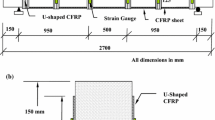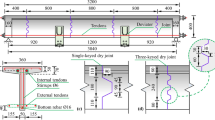Abstract
This paper experimentally studied the shear behavior of corroded post-tensioned prestressed concrete beams with full grouting. The effects of insufficient grouting in shear span on the shear behavior were also investigated. Eight beams were fabricated and divided into two groups: four beams with full grouting and four beams with insufficient grouting. Three beams in each group were subjected to accelerated corrosion. All beams were tested to failure in four-point loading. Experimental data on shear cracking, load-deflection response, shear strength and failure modes were presented. Results showed that strand corrosion accelerated the formation and propagation of diagonal crack. Insufficient grouting decreased the number of diagonal cracks. Strand corrosion degraded the post-cracking stiffness and shear strength. Insufficient grouting aggravated the propagation of diagonal crack and the degradation of post-cracking stiffness. The shear strength of corroded beam with 31.7% corrosion loss decreased by 15.44% as compared to that of the uncorroded beam. Strand corrosion loss less than 31.7% did not change the shear compression failure mode in fully grouted beams. The failure modes of locally ungrouted beams changed from shear compression failure to rupture of wires as the corrosion loss exceeded 39.6%.
Similar content being viewed by others
References
ACI Committee 318 (2010) Building code requirements for structural concrete (ACI 318-11) and commentary. American Concrete Institute, Farmington Hills, MI, USA
Ahmad S (2009) Techniques for inducing accelerated corrosion of steel in concrete. Arabian Journal for Science and Engineering 34(2):95–104
Austin SA, Lyons R, Ing M (2004) Electrochemical behavior of steel-reinforced concrete during accelerated corrosion testing. Corrosion 60(2):203–212, DOI: 10.5006/1.3287722
Azam R, Soudki K (2012) Structural performance of shear-critical RC deep beams with corroded longitudinal steel reinforcement. Cement and Concrete Composites 34(8):946–957, DOI: 10.1016/j.cemconcomp. 2012.05.003
Castel A, Coronelli D, Vu N, François R (2011) Structural response of corroded, unbonded posttensioned beams. Journal of Structural Engineering 137(7):761–771, DOI: 10.1061/(ASCE)ST.1943-541X. 0000315
Dai L, Bian H, Wang L, Potier-Ferry M, Zhang J (2020) Prestress loss diagnostics in pre-tensioned concrete structures with corrosive cracking. Journal of Structural Engineering 146(3):04020013, DOI: 10.1061/(ASCE)ST.1943-541X.0002554
De Wilder K, Lava P, Debruyne D, Wang Y, De Roeck G, Vandewalle L (2015) Experimental investigation on the shear capacity of prestressedconcrete beams using digital image correlation. Engineering Structures 82:82–92, DOI: 10.1016/j.engstruct.2014.10.034
Dhir R, Jones M, McCarthy M (1993) Quantifying chloride-induced corrosion from half-cell potential. Cement Concrete Research 23(6): 1443–1454, DOI: 10.1016/0008-8846(93)90081-J
El Maaddawy T, Soudki K, Topper T (2005) Long-term performance of corrosion-damaged reinforced concrete beams. ACI Structural Journal 102(5):649–656, DOI: 10.14359/14660
El-Sayed AK, Shuraim AB (2016) Size effect on shear resistance of high strength concrete deep beams. Materials and Structures 49(5): 1871–1882, DOI: 10.1617/s11527-015-0619-1
Gardoni P, Pillai RG, Hueste MBD, Reinschmidt K, Trejo D (2009) Probabilistic capacity models for corroding posttensioning strands calibrated using laboratory results. Journal of Engineering Mechanics 135(9):906–916, DOI: 10.1061/(ASCE)EM.1943-7889.0000021
GB 50010-2010 (2010) Code for design of concrete structures. GB 50010-2010, China Building Industry Press, Beijing, China
GB/T 228.1-2010 (2010) Metallic materials-tensile testing-part 1: Methodof test at room temperature. GB/T 228.1-2010, China Building Industry Press, Beijing, China
Huber P, Huber T, Kollegger J (2018) Influence of loading conditions on the shear capacity of post-tensioned beams with low shear reinforcementratios. Engineering Structures 17:91–102, DOI: 10.1016/j.engstruct. 2018.05.079
Juarez C, Guevara B, Fajardo G, Castro-Borges P (2011) Ultimate and nominal shear strength in reinforced concrete beams deteriorated by corrosion. Engineering Structures 33(12):3189–3196, DOI: 10.1016/j.engstruct.2011.08.014
Karihaloo BL, Abdalla H, Xiao Q (2003) Size effect in concrete beams. Engineering Fracture Mechanics 70(7-8):979–993, DOI: 10.1016/S0013-7944(02)00161-3
Khan I, François R, Castel A (2014a) Experimental and analytical study of corroded shear-critical reinforced concrete beams. Materials and Structures 47(9):1467–1481, DOI: 10.1617/s11527-013-0129-y
Khan I, François R, Castel A (2014b) Prediction of reinforcement corrosion using corrosion induced cracks width in corroded reinforced concrete beams. Cement and Concrete Research 56:84–96, DOI: 10.1016/j.cemconres.2013.11.006
Kim CG, Park HG, Hong GH, Lee H, Suh JI (2018) Shear strength of reinforced concrete-composite beams with prestressed concrete and non-prestressed concrete. ACI Structural Journal 115(4):917–930, DOI: 10.14359/51702224
Lee SC, Cho JY, Oh BH (2010) Shear behavior of large-scale post-tensioned girders with small shear span-depth ratio. ACI Structural Journal 107(2):137–145, DOI: 10.14359/51663529
Li F, Yuan Y, Li CQ (2011) Corrosion propagation of prestressing steel strands in concrete subject to chloride attack. Construction and Building Materials 25(10):3878–3885, DOI: 10.1016/j.conbuildmat. 2011.04.011
Mangual J, El Batanouny M, Ziehl P, Matta F (2013) Corrosion damage quantification of prestressing strands using acoustic emission. Journal of Materials in Civil Engineering 25(9):1326–1334, DOI: 10.1061/(ASCE)MT.1943-5533.0000669
Marí A, Bairán JM, Cladera A, Oller E (2016) Shear design and assessment of reinforced and prestressed concrete beams based on a mechanical model. Journal of Structural Engineering 142(10): 04016064, DOI: 10.1061/(ASCE)ST.1943-541X.0001539
Minh H, Mutsuyoshi H, Niitani K (2007) Influence of grouting conditionon crack and load-carrying capacity of post-tensioned concrete beam due to chloride-induced concreted corrosion. Construction and Building Materials 21:1568–1575, DOI: 10.1016/j.conbuildmat.2005.10.004
Minh H, Mutsuyoshi H, Taniguchi H, Niitani K (2008) Chloride-induced corrosion in insufficiently grouted posttensioned concrete beams. Journal of Materials in Civil Engineering 20(1):85–91, DOI: 10.1061/(ASCE)0899-1561(2008)20:1(85)
Oh BH, Kim KS (2004) Shear behavior of full-scale post-tensioned prestressed concrete bridge girders. ACI Structural Journal 101(2): 176–182
Papé TM, Melchers RE (2011) The effects of corrosion on 45-year-old pre-stressed concrete bridge beams. Structure and Infrastructure Engineering 7(1-2):101–108, DOI: 10.1080/15732471003588411
Park HG, Kang S, Choi KK (2013) Analytical model for shear strength of ordinary and prestressed concrete beams. Engineering Structures 46:94–103, DOI: 10.1016/j.engstruct.2012.07.015
Pillai RG, Gardoni P, Trejo D, Hueste MBD, Reinschmidt KF (2010) Probabilistic models for the tensile strength of corroding strands in posttensioned segmental concrete bridges. Journal of Materials in Civil Engineering 22(10):967–977, DOI: 10.1061/(ASCE)MT.1943-5533.0000096
Poston RW, West JS (2005) Investigation of the charlotte motor speedwaybridge collapse. Proceedings of 2005 structures congress and the 2005 forensic engineering symposium, April 20-24, New York, NY, USA, 1–11
Rinaldi Z, Imperatore S, Valente C (2010) Experimental evaluation of the flexural behavior of corroded P/C beams. Construction and Building Materials 24:2267–2278, DOI: 10.1016/j.conbuildmat.2010.04.029
Saqan EI, Frosch RJ (2009) Influence of flexural reinforcement on shear strength of prestressed concrete beams. ACI Structural Journal 106(1):60–68, DOI: 10.14359/56284
Schokker AJ, Breen JE, Kreger ME (2001) Grouts for bonded post-tensioning in corrosive environments. ACI Materials Journal 98(4): 296–305
Syroka-Korol E, Tejchman J (2014) Experimental investigations of size effect in reinforced concrete beams failing by shear. Engineering Structures 58:63–78, DOI: 10.1016/j.engstruct.2013.10.012
Vu NA, Castel A, François R (2009) Effect of stress corrosion cracking on stress–strain response of steel wires used in prestressed concrete beams. Corrosion Science 51(6):1453–1459, DOI: 10.1016/j.corsci. 2009.03.033
Wang L, Dai L, Bian H, Ma Y, Zhang J (2019) Concrete cracking prediction under combined prestress and strand corrosion. Structure and Infrastructure Engineering 15(3):285–295, DOI: 10.1080/15732479.2018.1550519
Wang XH, Li B, Gao XH, Liu XL (2012) Shear behaviour of RC beams with corrosion damaged partial length. Materials and Structures 45(3):351–379, DOI: 10.1617/s11527-011-9770-5
Wang L, Zhang X, Zhang J, Ma Y, Xiang Y, Liu Y (2014) Effect of insufficient grouting and strand corrosion on flexural behavior of PC beams. Construction and Building Materials 53:213–224, DOI: 10.1016/j.conbuildmat.2013.11.069
Woodward R, Williams F (1988) Collapse of Yns-y-Gwas bridge, Glamorgan. Proceedings of the Institution of Civil Engineers 84(4): 635–669, DOI: 10.1680/iicep.1988.179
Xia J, Jin W, Li L (2011) Shear performance of reinforced concrete beams with corroded stirrups in chloride environment. Corrosion Science 53(5):1794–1805, DOI: 10.1016/j.corsci.2011.01.058
Yalcyn H, Ergun M (1996) The prediction of corrosion rates of reinforcing steels in concrete. Cement Concrete Research 26(10): 1593–1599, DOI: 10.1016/0008-8846(96)00139-1
Ye Z, Zhang W, Gu X (2018) Deterioration of shear behavior of corroded reinforced concrete beams. Engineering Structures 168: 708–720, DOI: 10.1016/j.engstruct.2018.05.023
Yi J, Wang L, Floyd RW, Zhang J (2020) Rotation-affected bond strength model between steel strand and concrete. Engineering Structures 204:110060, DOI: 10.1016/j.engstruct.2019.110060
Zeng Y, Gu X, Zhang W, Huang Q (2010a) Study on mechanical properties of corroded prestressed tendons. Journal of Building Materials 13(2):169–174, DOI: 10.3969/j.issn.1007-9629.2010.02.008
Zeng Y, Huang Q, Gu X, Zhang W (2010b) Experimental study on bending behavior of corroded post-tensioned concrete beams. 12th biennial international conference on engineering, construction, and operations in challenging environments; and fourth NASA/ARO/ASCE workshop on granular materials in lunar and Martian exploration, March 14-17, Honolulu, HI, USA, 3521–3528, DOI: 10.1061/41096(366)336
Zhang X, Wang L, Zhang J, Liu Y (2017) Corrosion-induced flexural behavior degradation of locally ungrouted post-tensioned concrete beams. Construction and Building Materials 134:7–17, DOI: 10.1016/j.conbuildmat.2016.12.140
Zhang X, Zhang W, Luo Y, Wang L, Peng J, Zhang J (2020) Interface shear strength between self-compacting concrete and carbonated concrete. Journal of Materials in Civil Engineering 32(6), DOI: 10.1061/(ASCE)MT.1943-5533.0003229
Acknowledgements
This work was conducted with financial support from the NationalNatural Science Foundation of China (Grant No. 51678069, 51708477), the Graduate Student Research Innovation Project of Hunan Province (CSUST) (Grant No. CX2017B472), and the Project Funded by China Postdoctoral Science Foundation (Grant No. 2018T110837, 2017M620350). The supports are gratefully acknowledged.
Author information
Authors and Affiliations
Corresponding author
Rights and permissions
About this article
Cite this article
Wang, L., Hu, Z., Yi, J. et al. Shear Behavior of Corroded Post-Tensioned Prestressed Concrete Beams with Full/Insufficient Grouting. KSCE J Civ Eng 24, 1881–1892 (2020). https://doi.org/10.1007/s12205-020-1777-4
Received:
Accepted:
Published:
Issue Date:
DOI: https://doi.org/10.1007/s12205-020-1777-4




